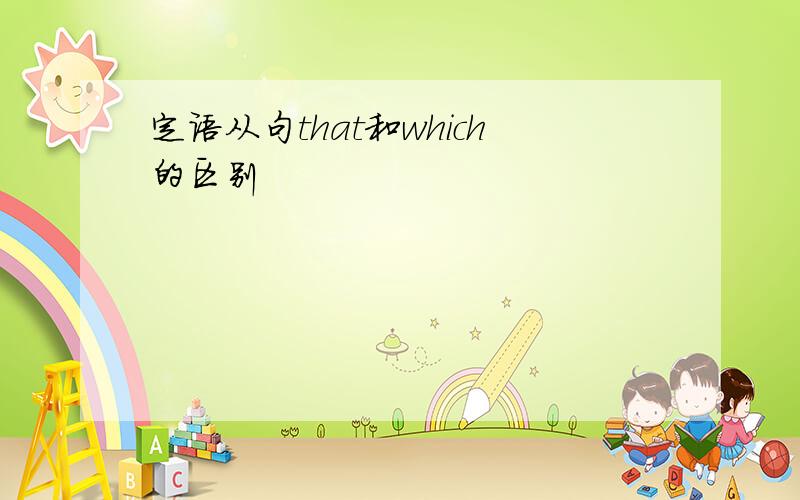定语从句that和which的区别
来源:学生作业帮助网 编辑:作业帮 时间:2024/04/27 05:04:27

定语从句that和which的区别
定语从句that和which的区别
定语从句that和which的区别
这个问题我已经回答过了,现在给你再抄一遍:
简单地说,如果定语从句和主句分不开,就用that.如果能分开,就用which.通常which的定语从句和主句之间是有逗号的,而that的从句永远不能用逗号和主句分开.
that和which的区别是限制性定语从句和非限制性定语从句的区别.that引导限制性定语从句,通常是不能省略的,如果省略了句子就不通了(或者表达的意思就变了).which引导非限制性从句,如果省略并不影响句子的整体表达.
限制性定语从句的例子:
Their dreams,and their songs,and their stories,are of the road that has no end.
这句话如果你把定语从句that has no end去掉,意思就不对了.
An adjective clause that is restrictive should not be set off by commas.
同样,这句话如果没有定语从句that is restrictive,意思就不对了.
非限制性定语从句的例子:
Thus the next task began of clearing Arab forces from the area and then rebuilding the road,which would be paved and five meters wide.
这句话如果你把定语从句which would be paved and five meters wide去掉,虽然少了从句里的意思,但是不影响主句的表达.
有时侯用限制性定语从句还是用非限制性定语从句完全取决于说话的人想强调什么.比如非限制性:
The painting,which was hanging in the foyer,was stolen.
强调的是画被偷了.而限制性:
The painting that was hanging in the foyer was stolen.
强调的是挂在门厅里的.
一关系代词的用法
1 who→在定语从句中做主语→用来指人
例句:我喜欢那个来自美国的男孩儿。
I like the boy who is∕comes from America.
2 whom在定语从句中做宾语→用来指人
例句:①我喜欢的那个男孩儿是汤姆。
The boy whom I like is T...
全部展开
一关系代词的用法
1 who→在定语从句中做主语→用来指人
例句:我喜欢那个来自美国的男孩儿。
I like the boy who is∕comes from America.
2 whom在定语从句中做宾语→用来指人
例句:①我喜欢的那个男孩儿是汤姆。
The boy whom I like is Tom.
②你正在等的那个医生现在在房间里。
The doctor whom you are waiting for is in the room now.
3 whose在定语从句中做定语→用来指人或指物
例句:①我认识那个叫汤姆的男孩儿。
I know the boy whose name is Tom.
②他喜欢那个窗户朝南开的房间。
He likes the room whose windows open to the south.
4 which→在定语从句中做主语或宾语→用来指物
例句:①这是你想要的那本书。
This is the book which you want.
②我喜欢红色的那辆车。
I like the car which is red.
5 that→在定语从句中做主语或宾语→用来指人或指物(可以用who, whom, which替换)
※ 必须用that的7种情况:
⑴先行词是all, everything, nothing, few, little等不定代词时,必须用that引导。
例句:我会告诉你我知道的一切。
I shall tell you everything that I know.
⑵当先行词被序数词或形容词最高级修饰时必须用that引导。
例句:①我不会忘记我学过的第一课。
I can’t∕won’t forget the first lesson that I learned.
②他是我见过的最可恨的人。
He is the most hateful person that I’ve seen.
⑶当先行词被all, every, little, few, no等修饰时,必须用that引导。
例句:我喜欢你给我的所有的书。
I like all the books that you gave me.
⑷当先行词被the only(唯一的);the very(恰好,正好);the same(相同的);the last(最后的)等修饰时,必须用that引导。
例句:你是我唯一喜欢的人。
You’re the only person that I like.
⑸当先行词既有人又有物时,必须用that引导。
例句:我不知道他们正在谈论的人和事。
I don’t know those persons and things that they are talking about.
⑹当that用做关系副词,修饰表示时间的名词时,可以代替when来引导。
例句:我不会忘记我第一次见到你的那一天。
I can’t forget the day that∕when I first met you.
⑺当句子中已有who出现时,必须用that引导。
例句:正在唱歌的那个女孩是谁?
Who is the girl what is singing?
6 as→在定语从句中做主语或宾语→用来指人或指物。
such…as… 如此像…,这样的像…,像…一样
the same…as… 相同的…,像…一样
例句:你们正在唱的那样的歌很流行。
Such songs as you’re singing are popular now.
二关系副词的用法
1 when→先行词表示时间
例句:我不能忘记在上海的那些日子。
I can’t forget those days when I was in Shanghai.
2 where→先行词表示地点
比较:where→定语从句中谓语动词为不及物动词时用。
that∕which→定语从句中谓语动词为及物动词时用。
例句:This is the place where I lived(不及物动词) last year.
This is the place which∕that(及物动词) last year.
3 why→先行词只有一个reason(原因)
例句:这就是我喜欢你的原因。
This is the reason why I like you.
收起
只要分清先行词是不是受到the only ,the very ,以及最高级的修饰,the last 等词的修饰。